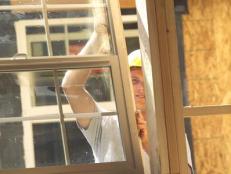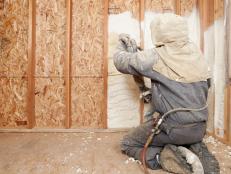Choosing Energy Efficient Windows for Your Home
Gone are the days when a homeowner's interest in windows was limited to whether they could find stylish window treatments. Today, energy-conscious homeowners want to minimize the costs of heating and cooling their homes, and selecting the right windows is a crucial step. So how far should you go when choosing energy-efficient windows? The key is knowing what window upgrades will give you the biggest bang for your buck without delivering a blow to your bottom line.
There are four factors to consider when choosing energy efficient windows: frame, glass, design and installation.
The Right Frame of Mind
Most people know a wood frame is less prone to heat and cold transfer than an aluminum one, since metals conduct temperature much more easily than wood. But that doesn't mean wood is always the best choice for a utility-bill-friendly window. There are a variety of materials available for window frames, and each has positive and negative aspects. It's up to you to decide what's best for your style and your budget.
- Vinyl: Just because vinyl is a less expensive material doesn't mean it has to be "cheap." A well-constructed, properly installed vinyl window can be a practical choice: budget-wise while still offering excellent energy efficiency measures through insulated glass and tight construction that reduces air leakage. Vinyl windows can be limited in color choices, however, and the fact remains that some people simply don't like the look of vinyl on their home.
- Wood: Wood windows offer the best insulative value, though they also require more upkeep than vinyl, wood-clad or aluminum frames. Because of the potential for rot, they may not be the best choice for extremely humid or rainy climates. A well-built wood window will stand the test of time, however: many original wood windows in older homes are still in good shape thanks to the high-quality cut and species of wood used, says Tamara Myers, president of Myers Constructs in Philadelphia.
- Aluminum: While not the top-performing material in terms of heat transfer and loss, aluminum windows are practical in rainy, humid climates, and they meet stringent coastal building codes in hurricane-prone areas thanks to their strength, says Johna Elisco, vice-president of All-American Doors and Windows in Pompano Beach, Fla.
- Wood-Clad: Wood-clad windows seemingly offer the best of both worlds: a low-maintenance exterior (usually vinyl or aluminum) encasing a temperature-transfer-resistant wood interior. But Jim DeLaPlaine, director of operations for Building Engineering-Consultants, Inc. of The Woodlands, Texas, cautions against these windows for wetter climates. Jim explains that clad windows can be prone to water intrusion, which can cause rotting, especially in the sills and jambs, where water tends to pool. He notes that proper installation of wood-clad windows should include use of waterproof rubber membranes around the cladding as well as a stand-alone flashing assembly called a sill pan. The sill pan drains any water that gets around the window sills and jambs, minimizing moisture intrusion (and resulting wood deterioration).
Inside the Glass
While the material each window is constructed from is important, the reality is most recent window-related buzzwords are all about what's inside the frame. But what do all these upgrades mean for homeowners?
John Lala, president of Rycorp Construction in Virginia Beach, Va., is familiar with the gamut of efficient window options. He's built houses in all price ranges, from bare-bones-basic structures to million-dollar-plus projects with very eco-conscious clients. And after seeing everything out there and talking to lots of homebuyers, he says he ends up using windows with the same basic energy-efficiency features in most of his projects.
"A double-paned window with Low-E glass, with a vacuum-sealed argon fill — that's what people ask for," he says. "It's an extra $40 or so per window for me to add these features, and they really do make a difference in a home's utility bills." John says he's found that doing anything more, like using triple-paned glass or denser gases with greater insulative properties, "just adds cost and gives diminishing returns in efficiency."
So what exactly are you getting when you choose a window with the aforementioned options? "Low-E, argon-filled, double-paned windows provide significantly more insulation than a single-pane window," explains Kendra Weinisch, a residential energy efficiency consultant in San Jose, Calif. "These windows protect the inside of the house from the sun's heat and UV rays in the summer, and they prevent heat from escaping during winter. From the standpoint of energy efficiency and value, these types of windows make a lot of sense."
Kendra adds that while triple-paned windows may be notably more efficient in especially harsh winter climates, they can also reduce the window's visibility and light transmittance.
You shouldn't have to look much further than a window's glass to find out what the unit's efficiency features are. All windows in the voluntary Energy Star program will have a sticker on them with ratings from the National Fenestration Rating Council (NFRC). To qualify for Energy Star status, window manufacturers have to meet standards on these two main metrics:
- U-value: measures a window unit's resistance to heat loss
- Solar Heat Gain Coefficient (SHGC): measures how much heat enters a home through the glass
For both U-Value and SHGC, the lower the number, the better the window should perform.
Designed for Efficiency
Some window designs are inherently more efficient than others. The most common types:
- Double-hung windows: These are traditional units in many homes across the country, and they're especially common in pre-war buildings. With double-hung windows, the bottom slides up to open the unit. They can be efficient choices, but in really extreme climates, they may not be the best option because of the potential for air intrusion between the sliders.
- Casement windows: Popular in climates where wind is an issue, these units, which have a crank that swings the window outward to open, actually seal themselves off tighter when wind blows in toward the house. They do require maintenance on hinges and seals, however, to ensure their continued stability and efficiency.
- Picture windows: These usually don't open and come in many different shapes and sizes, but that doesn't mean they can't be efficient — glass choice and gas-filled interiors are especially important in these larger units.
Sealed From the Elements
Finally, don't overlook the importance of proper installation. Even the most expensive window unit won't perform effectively if it's not installed correctly. Jim says to be wary of any contractor who relies too heavily on expanding foams or sealants to get a window to fit well — these materials aren't waterproof and can lead to problems down the road. Pre-installation waterproofing, often completed long before windows are installed, is the best option, he says.
Flashing and proper caulking may be the cheapest parts of window installation, but if they're not done with an eye to detail, the ensuing water leaks will cause a barrage of problems that could have been easily prevented.







































